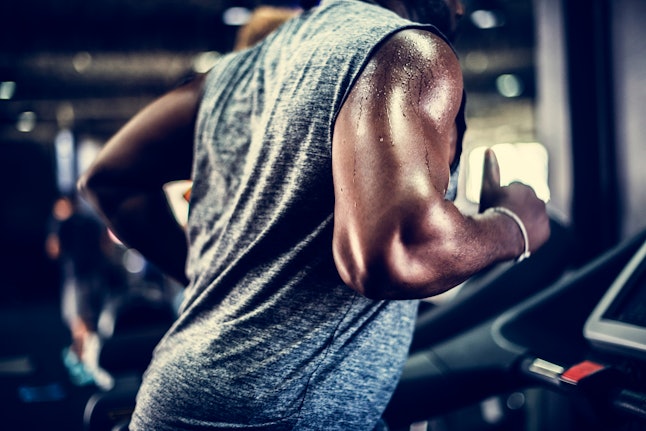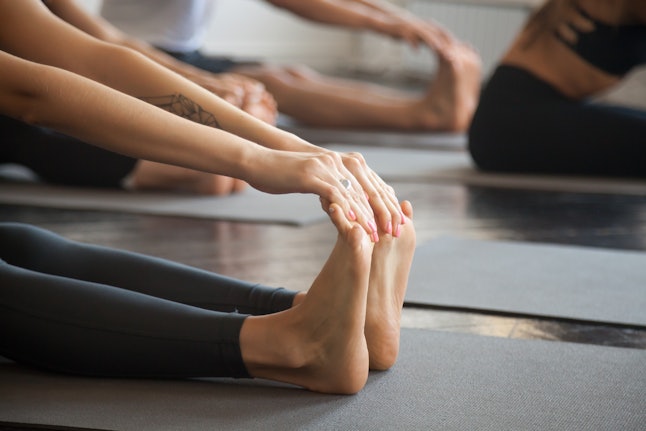Forum
The gym is the ideal place to pick up toned abs, a healthy workout glow, and a ringworm infection. On the upside, you’ve got access to thousands of dollars-worth of high-tech gym equipment that just won’t fit in your hipster-container of a home. On the downside, you’re essentially exercising inside a petri dish of bacteria, fungi, and viruses looking for a sweaty-but-fabulous host to infect. That being said, there’s no need to let the microscopic bastards get you down. Armed with a little knowledge, some flip flops, and plenty of clean towels, there’s a lot you can do to prevent picking up the most common gym skin infections.
For the most part, avoiding skin infections at the gym just takes some basic common sense, says Dr. Joshua Zeichner, dermatologist and director of cosmetic & clinical research in dermatology at Mount Sinai Hospital in New York City.
“Generally speaking, if your skin barrier is functioning optimally and you practice good hygiene, it is unlikely that you will develop an infection," Zeichner adds. "However, if the skin barrier is disrupted, it allows microorganisms to invade more easily and if you don’t wash the skin after you come in contact with an organism, it has time to grow and cause an infection." He suggests making sure to cover any open wounds, clean any gym equipment of visible sweat before using it, and wear flip flops in the shower.

rawpixel.com / Shutterstock
“We’ve always got microorganisms on our skin, and that’s not always a bad thing,” he adds. And we definitely need some of those. A recent trend called the “Hygiene Hypothesis” has pointed to evidence that being overly clean by attempting to eliminate all bacteria and germs from the environment can have a negative effect on the immune system, so there’s no need to bathe your entire body in hand sanitizer after a workout.
Dr. Joel Schlessinger, a Nebraska-based dermatologist, tipped us off to a simple gym hygiene method that just might be genius: “Put a dark X with Sharpie marker on the towel on one side only and use that as the side of the towel that touches the equipment. Use the non-X side to wipe your face and body while working out.”
If you don’t, you could be in for one or several of the following skin issues. Here are some of the most common ones, from the annoyingly itchy to the potentially deadly (with a few moderately gross ones in between).
Ringworm
The good news is that there are absolutely no worms involved with ringworm in any way, so if you catch it, it’s not like your body has been invaded by the Mindflayer from Stranger Things. The bad news: Ringworm is a “tinea infection” from the same family of fungi that cause athlete’s foot and jock itch, and according to Schlessinger, it’s “very contagious.”
“Ringworm is a fungus or collection of funguses that thrives on dead tissues like nails, hair, and skin,” says Schlessinger. “It is contagious even before symptoms appear, because it can live on objects such as clothing or towels for much longer than ordinary bacteria.”
Athlete's Foot
Athlete’s foot is one of the most common infections you can pick up from your workout. It’s caused by the tinea fungus which thrives in warm, moist areas like locker room floors, showers, or right inside your sweaty socks. It’s characterized by a red, itchy rash and/or cracked skin and often starts in between the toes.
Some people say that urinating on your feet in the shower can help to prevent athlete’s foot because urine contains urea, a compound sometimes found in creams that treat dermatitis or psoriasis. Both of the experts I spoke to about this prevention method said those people are gross. “While urine contains an anti-microbial ingredient called urea, the levels [of it] are quite low and it is unlikely to prevent a fungal infection,” says Zeichner. “I recommend leaving the urine for the toilet rather than the shower."
“Yuck,” adds Schlessinger.
Jock Itch
Hello again to the same fungal infection in an even more unpleasant place. The crotch is another profoundly warm and sweaty place on the body, especially after a hardcore workout. Jock itch starts as a red patch of skin emanating from the folds in your private area that can be itchy and flaky and in some cases carries small red blisters.
Jock itch can come from close contact with another person with the infection, from touching another infected area on your body (like your feet) and then giving that groin area a scratch, or from touching unwashed clothes that carry the fungus. Because of the delicate area jock itch affects, it’s always important to check in with your doctor if you think you’ve picked up this infection. In many cases, your doc may suggest over the counter creams or lotions that you use for a week or two, but it’s important to confirm that what your dealing with really is “just” jock itch and not something a sexually transmitted infection that’ll warrant different treatment. The treatment for athlete’s foot and jock itch is much the same — over-the-counter creams and sprays that contain Lotrimin or Clotrimazole.
OTC treatments are fine, but if the infection doesn’t appear to be improving within a few days, it’s time for a trip to the dermatologist. “Early treatment can cure these infections quickly,” says Zeichner. “The longer you wait, the more difficult it may be to fully eradicate the infection.”
Tinea Versicolor
Sounds exotic right? It’s not.
“Tinea Versicolor is a fungus — yeast, specifically — that lives on the skin,” says Schlessinger. “Usually, it doesn’t disrupt the skin, but when triggered by humidity, hormonal changes, etc., the fungus may begin to overgrow and cause changes in skin color.”
This fungus can appear as scaly or discolored patches and my expert notes that it often goes unnoticed until summertime when the patches appear lighter or darker than the surrounding skin. While you’ve already got this fungus lying dormant on your skin, Schlessinger says it is often “reactivated” at the gym because it thrives in hot, humid environments like saunas or especially tanning beds.
Plantar Warts
This gym infection distinguishes itself from the rest of the bunch because it’s a viral infection, not a bacterial or fungal one. Plantar warts are hard, painful growths that appear on the bottom of your feet. The reason you may be more apt to pick them up at the gym is that locker rooms and swimming pool areas are warm, moist environments where people frequently walk barefoot. Not-so-fun fact: Both plantar warts and genital warts are caused by Human Papilloma Virus (HPV).

fizkes / Shutterstock
“Sometimes, these warts can go away on their own, but a dermatologist should always examine the area to determine if the concern is a wart or something more serious like skin cancer,” says Schlessinger. “The treatment depends on the wart’s size and location, but can be removed with cryotherapy, burning, or a wart poison.” He also recommends that people consider getting the Gardasil-9 vaccine developed to prevent genital warts, because it can help you avoid regular warts as well.
Impetigo
The most common causes of the bacterial skin infection impetigo are staph (more on that in a minute) and strep, so you can contract it anywhere, but the extra danger of the gym is the moist environment and the contact with equipment used by others who may not even know they’re infected. Schlessinger says that impetigo most commonly colonizes on a compromised area of skin such as a cut, scratch, bite, or rash.
Impetigo is highly contagious and can be contracted through skin-to-skin contact, broken skin, humid environments, or during contact sports,” says Schlessinger. “Indications of impetigo are red sores on the face around the nose and mouth that may have a crust and may ooze. A more serious form, Ecthyma, can cause painful sores that eventually turn into deep ulcers.” This is one infection that may require antibiotics to clear up, so check in with your doctor if you’re seeing signs.
Hot Tub Rash
While we have yet to scientifically establish that these bubbly pools of bacteria can cause time travel, hot tub rash is quite real. It’s known more formally as Pseudomonas folliculitis and you can actually catch it from any warm pool or lake where the bacteria Pseudomnas aeruginosa grows and chlorine and pH levels are not properly maintained. Hot tub rash manifests as a collection of red or white bumps near hair follicles one or two days after exposure to infected waters.
Schlessinger is not a hot tub fan himself but understands that warning his patients off hopping in the jacuzzi altogether is unrealistic. He recommends thoroughly cleansing the skin immediately after swimming (or whatever you’re doing) in that hot tub. He even has a product in his own skin care line called CLn BodyWash, that aims to prevent folliculitis because it contains a gentle concentration of bleach known as sodium hypochlorite. “The main thing is that if you have any doubt the hot tub or pool has not been properly maintained, don’t risk going in it,” says Schlessinger.
Staph
There are more than 30 different types of staphylococcus bacteria, but the one that most commonly causes infection is called staphylococcus aurelius. This creepy crawler is by no means exclusive to the gym environment, but athletes may be at greater risk for a staph skin infection because they may touch other people’s skin during contact sports or use the same gym equipment.
“Sadly, it is rampant in gyms these days,” says Schlessinger. “Since staph comes in many forms and can become a serious issue if not properly treated, you absolutely must see a dermatologist if you suspect you have staph. Most of the time, the nose is affected to some degree with a painful or irritating 'sore' on it that is easily noted on touching or moving your tip of the nose.” Other telling symptoms can be found here.
MRSA
MRSA may not be able to bench press as much as you do but this nasty bacteria is still hella strong. In the worst cases, it can cause sepsis which can lead to organ malfunction and even death. According to the CDC, about 2% of the population are carriers of MRSA bacteria but few show any signs of sickness or infection. The problem comes if one of these benevolent carriers happens to be using the rowing machine right before you and you’ve got an uncovered cut on your hand.
MRSA can live on a piece of athletic equipment anywhere from several hours to several weeks. The EPA even has a list of approved cleaning products for killing the MRSA that could be lurking on your spin class bicycle seat.
“Since MRSA is a form of staph, it can be contracted in the same places that staph can—anywhere. MRSA is a more virulent form of staph. This form is more resistant to antibiotics and is more commonly found in hospitals or similar settings,” says Schlessinger. "MRSA often begins as bumps that appear swollen and are painful, much like a pimple or a bug bite. Most of what dermatologists such as myself see that are self-diagnosed as 'spider bites' turn out to be staph or MRSA.” If you suspect that you have MRSA or any sort of staph infection, see your dermatologist immediately.
More like this
When I go to the YMCA swimming I always wear disinfectable sandals from the changing area to the pool edge. After coming out my sandals are right there to slip back into. I wear them in the shower also. Always dry your feet well with your towel.
Good gym practices include wearing clothing that covers the body where contact with equipment is made, using a gym that mandates clients clean the machines after use, wearing shower shoes if a locker room is used, using specialized socks for yoga classes instead of bare feet, and not going to the gym when ill.
If fungal infections are contracted such as athlete's foot, it is very important for your clients to know that they need to continue treatment for at least 3 weeks even if the rash seems to be all better. If after using an OTC no improvement is observed, seeing a doctor is necessary.
There are a number of different infections that can be acquired in the gym if not careful and aware. It is important to always clean off the equipment you use before and after you use it for your own safety and for others as well as a common courtesy. Hundreds of gyms provide a sanitation station consisting of of disposable paper towels and disinfectants to wipe down machinery when done. It is also good practice to shower using shower shoes to avoid fungal infections.
I like the idea at my gym where whenever you use a machine you must wipe it down with a wipe after. By maintaining a clean gym it helps to eliminate many bacteria which protects gym members and even staff members.
A numerous number of people don't even think twice about the infections and diseases that can be spread at the gym, especially before covid. I always bring shower shoes if I need to use the gym shower for any reason, or if I am walking around the pool. It is important to maintain safety precautions to avoid the spread of any type of infection or disease because you never know where it can come from.
@emmamidgettiectskin-com My gym started doing that after covid and it is nice to know that I don't have to touch other people's sweat while I work out.
@deborah I also always bring a pair of just rubber shoes to wear around areas like the pool and the locker room.
making sure to clean and spray equipment to me is so important before and after use, always wearing protective shoes to avoid fungal infections.
@madisonmauldiniectskin-com athletes foot is the most common infections i've seen after workouts at the gym.


